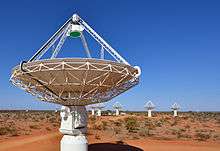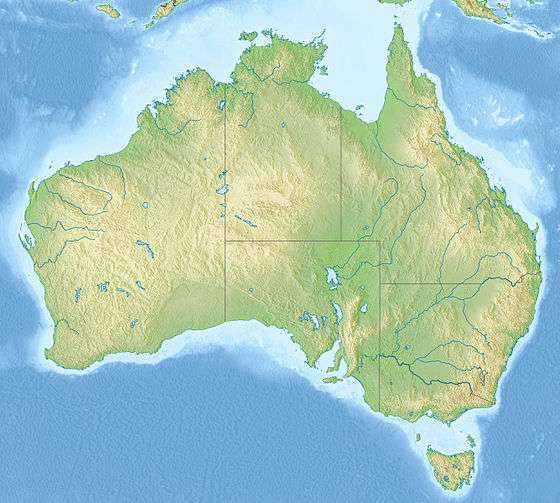Murchison Radio-astronomy Observatory
 Close up of an ASKAP antenna with several more in the background | |
| Alternative names |
MRO |
|---|---|
| Location |
Boolardy, Western Australia, Australia |
| Coordinates | 26°42′15″S 116°39′32″E / 26.7042°S 116.659°ECoordinates: 26°42′15″S 116°39′32″E / 26.7042°S 116.659°E |
| Established |
2009 |
| Telescopes |
Australian Square Kilometre Array Pathfinder Experiment to Detect the Global EoR Signature Murchison Widefield Array |
 Location of Murchison Radio-astronomy Observatory | |
|
| |
The Murchison Radio-Astronomy Observatory (MRO) was founded by CSIRO in 2009.[1] It lies in a designated radio quiet zone located near Boolardy station in Western Australia.
It currently comprises two main instruments: The Murchison Widefield Array (MWA), a low-frequency array operating in the frequency range 80-300 MHz; and the Australian Square Kilometre Array Pathfinder (ASKAP).[2]
It is also one of two core sites for the Square Kilometre Array (SKA), and both current instruments are technology and science pathfinders for the SKA.[3]
Several smaller experiments (CORE, EDGES, PAPER and SCOPE) will also be sited at MRO.[4][5]
MRO Telescopes
Australian SKA Pathfinder (ASKAP)
The Australian Square Kilometre Array Pathfinder (ASKAP) was built by CSIRO and comprises 36 identical antennas, each 12 metres in diameter, working together as a single instrument. ASKAP’s combination of fast survey speed and high sensitivity will allow astronomers to answer some fundamental questions about the creation and early evolution of our Universe, and to test theories of cosmic magnetism and predictions from Einstein's general theory of relativity.[6] The facility was formally opened on 5 October 2012.[7]
Murchison Widefield Array (MWA)
The Murchison Widefield Array (MWA) is a joint project between an international consortium of universities to build a low-frequency radio array operating in the frequency range 80-300 MHz. The main scientific goals of the MWA are to detect neutral atomic Hydrogen emission from the cosmological Epoch of Reionization(EoR), to study the Sun, the heliosphere, the Earth's ionosphere, and to study radio transient phenomena. The MWA is the first so-called large-N array, fully cross-correlating signals from 128 phased tiles of 16 crossed dipoles (each). The field of view is large by the standard of astronomical instruments, being on the order of 30 degrees across.
Experiment to Detect the Global EoR Signature (EDGES)
The Experiment to Detect the Global EoR Signature (EDGES) is a radio telescope being developed by MIT Haystack Observatory and Arizona State University (ASU) to make accurate measurements of the sky brightness temperature between 50 MHz and 200 MHz. Its scientific objective is the detection of the global (sky-average) redshifted 21-cm line from Cosmic Dawn and the Epoch of Reionization corresponding to the redshift range 27 6.[8]
Radioquiet Zone
The MRO has been designated a protected radio quiet zone by the Australian Communications and Media Authority (ACMA) since April 2005, and in July 2011, an enhanced radio-quiet zone was imposed. The initial radio-quiet zone (renamed to the inner zone) was a protected zone in a 70 kilometre radius around the MRO, in which all radio apparatus licenses needed to be made with the approval of the MRO governing body. The enhanced radio-quiet zone adds a second zone, effectively extending the license approval governing area from a radius of 70 kilometres to 150 kilometres.[9]
Related Lists
References
- ↑ "Murchison Radio-astronomy Observatory". SKA. Retrieved 19 July 2018.
- ↑ "Murchison Radio-astronomy Observatory". CSIRO. Retrieved 19 June 2012.
- ↑ "Technology and Science". Australia and New Zealand SKA project. Archived from the original on 30 July 2012. Retrieved 19 June 2012.
- ↑ "The Murchison Radio-Astronomy Observatory (MRO)". University of Western Australia. Retrieved 20 June 2012.
- ↑ "Operations: Murchison Radio-astronomy Observatory and Geraldton support". International Centre for Radio Astronomy Research. Retrieved 20 June 2012.
- ↑ "ASKAP Science Update, Vol. 1", CSIRO, retrieved 8 November 2010 from http://www.atnf.csiro.au/projects/askap/ASKAP_Science_Update_1.pdf
- ↑ http://www.abc.net.au/rural/content/2012
- ↑ "MIT Haystack Observatory: EDGES". Massachusetts Institute of Technology. Retrieved 20 June 2012.
- ↑ "Planning for the radio astronomy service". ACMA. Retrieved 19 June 2012.